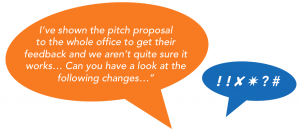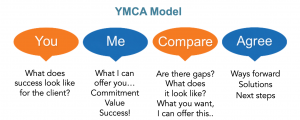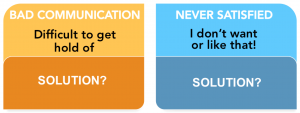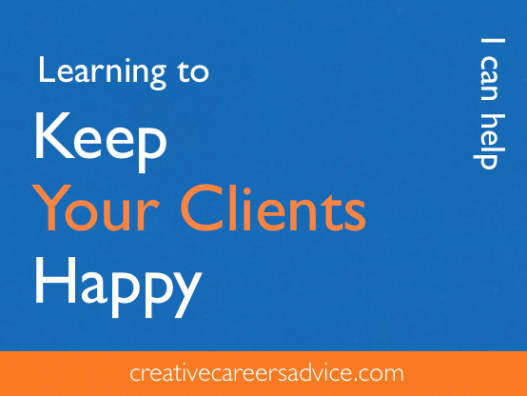Why is it important to learn how to maintain good client relationships and form a positive approach to feedback?
There are many kinds of client / creative relationships that you’ll experience throughout your career and learning to engage, impress and maintain effective working partnerships will be a central part of your creative skillset.
Good communication, negotiation and management are just some of the core strengths you need and when your clients start the process of giving you feedback, include: empathy, resilience, listening and a good dose of patience…

Client Relationships
It’s important to know the different kinds of client engagement and how to approach the relationship, as there are many ways to managing them.
Identifying The Personality Type of Clients
By getting to know your clients you’ll form a much more successful relationship and outcome for both parties.
In your initial meetings set some time aside to engage with them on a more personal level. Whilst it is expected to keep things on a professional level, some clients may be more receptive to a more friendly interaction; but tread carefully and gauge their response first.
If you are able to understand their personality type it will help the project process, as you learn how your client(s) react to your service and solutions, avoiding unnecessary conflict and misunderstandings along the way. A big bonus.

Have a look at this website that explores personality types, it purpose is to help us become more familiar with different characteristics and behaviours. https://www.16personalities.com/personality-types
The Perfect Client
In an ideal world we want to work with people who will make the experience mutually beneficial, where clients:
- Know what they want
- Have a business plan and a clear USP
- Come with value & mission statements
- Understand their brand and strategy
- Know their budget limitations
- Deliver a concise and realistic brief
- Are happy to agree a clients contract and ‘needs analysis’ plan
- Have great communication
- Provide a single point of contact
- Provide content on time
- Understand the creative & production processes
The Imperfect Client
They may lack some or almost all the above, which is rare, so either you don’t engage and lose the contract, or learn how to deal with each client by a process of listening and interpretation.
Every Client Has A Different Story To Tell
We need to understand the pressures and roles each person/client carries with them… and be sensitive to it as we work with them. So it needs to be second nature to us to recognise this.

Understanding Client Stresses & Tensions
- Tell them what’s happening - & what will happen next
- Make sure you’re busy & attentive - is everything going well?
- Inquisitive to their needs - talk to your clients, find out what makes them tick
- They’re often not like you – they might be older, less interested in creativity etc.
The Perfect Creative - It’s A 2-Way Relationship
Your Client Is Your Customer:
- Be nice, be respectful, be humble, be memorable, be yourself
- Be honest, but tactful
- Speak clearly & listen – especially to what they’re really saying
- Be empathetic – understand their point of view & pressures
- Don’t take criticism personally - pick your battles
- Make sure everyone understands your pitch, don’t be vague
- Do not overpromise - Do what you say you’ll do - then surprise with extra value
- Help clients with first class work - they’ll come back for more
- Learn with your clients, get personal and understand who they are
An Introduction Framework
To help an agency communicate a client’s message successfully and meet their aims and objectives it’s important to stop, listen and learn a bit more about the company.
Here is a 3-step client engagement process:
- On-boarding Process for creative agency & client - Implementing a project management structure & timeline from: initial enquiry, brief setting, and proposal to green lighting the project etc. (See my blog on ‘Working with a Creative Brief’).
- Creative Agency’s ‘Brief Questionnaire’ for the client - Questions about the contacts, the company, the brief, marketing direction, brand personality etc.
- Client Brand Health Check - helps discover gaps in a brand’s development and define the challenges.
Handling & Managing Client Feedback

A client may be satisfied with what you do… or perhaps they wont…
There are ways we can deal with these situations and a lot of the time it’s to do with both party’s personalities and understanding of each other.
Q: Think about this statement and whether it applies to you?

Can we accept that feedback is about the work you do… and not necessarily about you. Is it possible to create the separation?
Design by committee is common client behaviour…

Above is a recurring example where everyone bar the CEO is invited to feedback on your creative concepts... Challenging as it can be - don’t make receiving feedback personal.
Listen for the ideas behind the words
What do they want?
Clients sometimes may not articulate exactly what they mean when giving feedback. It often falls to the creatives to figure out what’s being said about the work being assessed…

This is where a professional and not an irrational response is essential. In time, your negotiation and diplomatic skills will prove key to ensuring relationships don’t get frayed and break down - that your adept at reassuring, understanding and responding positively and maintaining a good rapport and successful outcomes.
Client Feedback & How to Respond
(Rules of Engagement)
Read the following reactions & ‘feedback’ from clients. And think about the solutions provided - these are tried & tested responses that many agencies will employ as a matter of course with their clients in order to establish a ‘rules of engagement’ framework.

Solutions that in time you will adapt and create for yourself

Developing Empathy
Empathy = the ability to understand and share the feelings of another.
Understand the Other Person’s Point of View. Receiving criticism can be unpleasant. However, it’s important to realise that the other person is likely to be uncomfortable as well. They probably don’t like giving it anymore than you like hearing it.
So be sensitive to the fact that others may see & interpret solutions differently to you.
Being around frank, honest people in your creative space who aren’t afraid to give feedback on the fly will help you to become more comfortable hearing it. You’ll be more skilled at listening and giving critical feedback, helping you to better understand your clients and their needs.
Giving + understanding = happiness
Positive feedback provides ways to create improvements and changes… making it easier for us to hear the rest of the criticism.
Say: 'Thank You’ This lets people know that you’re open to critical feedback. Opening that door provides you with more opportunities for growth, including being able to hear constructive feedback at all times without becoming defensive.
To avoid relationships getting stuck and deteriorating (and they can and do…), create frameworks to help the process - developing clarity and openness, but most of all that all important empathy. Here’s a useful framework:

Conclusions
Make that journey into the 'positive zone'...
as you may find yourself having to cope with challenging clients & critical feedback

So it's important to understand where you stand with:
1) What the client wants from you. 2) How your going to deliver. 3) Maintaining a good relationship for future collaboration.
So regularly measuring your performance and responses as you and your client journey through the project together makes sense strategically and for future proofing.
Actions: Why not have a go at finding your own response and solution to the following client feedback:

© Paul E P Butler is Creative Careers Adviser, Design Director and HE Lecturer in employability and Creative Industry careers.
For one-to-one creative careers advice and coaching contact me at: creativecareersadvice.com
If you found this blog useful share it with your contacts and follow me for more posts on creative careers advice and employability topics.
Other related blogs you might want to reference to learn more about becoming a good communicator: ‘Confidence In Public Speaking’ and ‘Self Promotion & Portfolios’
Why not sign up for membership of Tern Heads: https://ternheads.com/
A creative community of peers and professionals, dedicated to entry-level talent. We offer a network of accessible opportunities and a space to showcase your work to potential employers.
